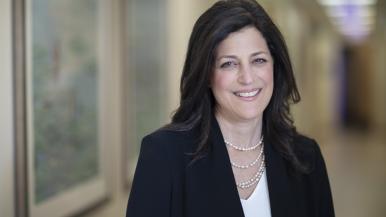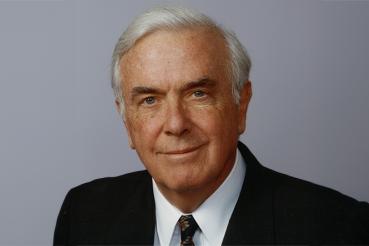Rush has been an innovator in breast cancer screening for many years. What are some of the ways we’ve moved the field forward?
Mammography is an excellent screening tool for breast cancer. It is the most studied test in medicine and shows a 40% decrease in mortality for women who are screened. But mammography is not perfect. For two groups of women — those with dense breast tissue and those with a higher lifetime risk of breast cancer — it is not as good at identifying cancers. Other screening modalities in addition to yearly mammography should be pursued to find breast cancer at its earliest stage when it is most treatable. Rush has been a pacesetter in supplemental screening.
In 2017 we started offering automated breast ultrasound, or ABUS, which scans the entire breast. We started the program two years before Illinois required providers to notify women if they have dense breast tissue. We didn't want to just send women a letter and not offer support. We wanted to give them the option of another test. A lot of women visiting us are now in the habit of scheduling their mammogram and ABUS together.
Your team launched the personalized screening program to recommend care tailored to women’s risk of breast cancer. Why did you start this program, and how does it work?
Since 2007 the American Cancer Society has recommended MRI for women who are high-risk, meaning they have a greater than or equal to 20% lifetime risk of breast cancer. The problem is, how do women know they are high-risk? Some women know they are high-risk because they’re aware of a genetic mutation, but that's a very small percentage. Three out of four women diagnosed with breast cancer have no family history.
In 2020 we started the personalized screening program using cancer risk assessment software. The assessment is free, and we offer it to every patient who visits any Rush breast imaging location. We ask a few questions and use software that leverages additional information from the patient’s electronic medical record to calculate their lifetime risk of breast cancer.
We put three things in our report: if they are high-risk and meet recommendations for supplemental screening with MRI; if they meet the recommendations for genetic testing; and if they meet the recommendations for risk-reducing medication.
We also brought in a nurse navigator, which is a game-changer. She reaches out to every patient who is high-risk, goes over what the results mean, explains the recommendations and then refers them to Rush's high-risk breast clinic. There, patients meet with advanced practice providers, breast surgeons and other specialists to help them navigate what's next.
Rush's personalized screening program is garnering national attention. What impact has it had on patients and on the field at large?
So far, we have performed risk assessment on 42,000 women and identified 3,900 as high-risk. Our uptake for people who qualify for MRI is in the 30% range — double the national average. We've found 44 very early cancers with MRI, which is a very high number in two years.
Recently, we saw a patient who came in for a mammogram. She was high-risk: Her mom and maternal grandmother had breast cancer. Her mammogram was read as normal, but she talked to the nurse navigator and came back for an MRI six months later. We found two cancers — one in each breast — and she had them both removed. No cancer was detected in the lymph nodes following surgery, and the patient is now cancer-free. Waiting for these cancers to grow large enough to be detected on a mammogram alone would have reduced the likelihood of this patient’s successful outcome.
How does donor support make a difference for you and your colleagues?
Philanthropy is the reason we have been able to do this work. It has funded research nurses, nurse navigation, data analysts, cutting-edge equipment and information technology specialists to build out this program as seamlessly as possible.
Donor support also allows us to publish our results and share them with colleagues across the country. It helps us train new physicians in breast health and imaging. I’m proud that we’ve already had 12 medical students participate in this research.
The U.S. Preventive Services Task Force recently issued recommendations that women should start getting regular mammograms at 40. What guidance do you have for women who hear differing guidelines? How could personalized risk assessment shape the future of screening recommendations?
There are a lot of recommendations out there, and it can get confusing. I prefer the American College of Radiology guidelines, which has recommended for years that we start screening at 40 and do it every year. These recommendations will unequivocally save the most lives.
I'd add that any recommendations to start screening later than age 40 disproportionately hurt Black women. Black women get breast cancer earlier, and they are more likely to get a very aggressive breast cancer that you must screen for every year to catch early enough to impact prognosis and survival.
I want to bring the cancer risk assessment tool into primary care, so all women can undergo risk assessment at age 25-30. In the breast imaging center, we usually don’t see women until they're 40, and the incidence of breast cancer for women under 40 is significantly increasing. Nobody knows why, but I'm seeing it every week. Since we don’t screen the entire population before age 40, we need to find high-risk women so they can start screening between ages 25-30.
What implications does your work have on the future of early detection and saving more lives from cancer?
Our program is set up as a learning health care system, so we gather data on all patients who participate. It lets us study everyone, not just people in clinical trials, and allows us to modify our recommendations based on this data. There's a lot of opportunity to use the personalized screening program for breast cancer as a model for other cancer screening programs. For example, lung cancer is responsible for the most cancer deaths around the world. It kills more women than breast and ovarian cancer, combined, but a very small percentage of eligible individuals get screened for lung cancer. We are adding lung cancer screening questions to our intake form in breast imaging to uncover women who qualify for lung cancer screening in the hopes of improving early detection of lung cancer.
To learn more about supporting Rush’s leading research in cancer screening, please contact Charles Palys at charles_palys@rush.edu or (312) 563-9049. You can also make a gift online to directly support innovation at the Regenstein Breast Imaging Center at Rush.




